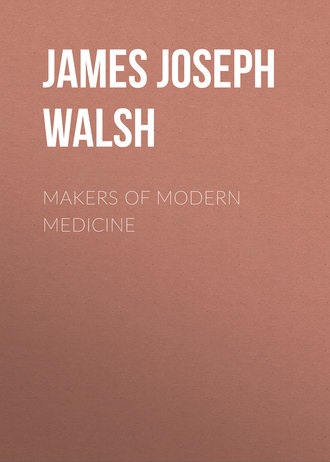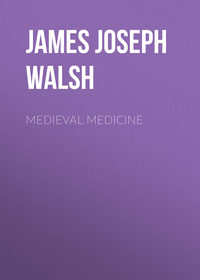 полная версия
полная версияMakers of Modern Medicine
Leopold Auenbrugger, afterward Edler von Auenbrug–a term about equivalent to the English "Knight of Auenbrug"–who thus stands at the head of modern medical diagnosis, was born on the 19th of November, 1722, at Gratz, in Lower Austria. His early education was received at Gratz, and it seems to have been of rather a comprehensive character, for Auenbrugger, later in life, was a member of the elegant literary circles in Vienna and a welcome friend at the tables of cultured and distinguished fellow-townsmen. It will be recalled, by those who remember German literature, that at this time Vienna was the centre of culture in Germany, attracting many literary men–as, for instance, the two Schlegels–from other parts of Germany.
Auenbrugger's father was of the lower middle class, the proprietor of the Gasthaus Zum Schwarzen Mohren, in one of the suburbs of the city of Gratz, but also the owner of another hotel in the city itself, so that he was able, by making some sacrifices, to afford his son a university and medical education in Vienna. The family were not in very affluent circumstances, however, and in this Auenbrugger was in the same condition as many other of the distinguished medical men who have made important original discoveries. Volta, Laennec, Johann Mueller, Helmholtz, Pasteur and Virchow were all the sons of comparatively poor parents, and had to eke out their university education by doing teaching work as soon as they were considered capable.
Auenbrugger's studies in medicine were pursued under the well-known Baron Van Swieten. Van Swieten was, as has been said, one of the most distinguished of Boerhaave's pupils, and devoted most of his life to writing a set of commentaries on Boerhaave's aphorisms and editing his master's work. Van Swieten's greatest ambition was to make the Austrian capital the home of the great clinical school of medicine and a pilgrimage at least as attractive for physicians seeking to study practical medicine at the bedside as had been his own alma mater at Leyden. He was of so great administrative ability that Maria Theresa made him one of her state counsellors.
With all the influence of the government behind him, then, it is not surprising that Van Swieten succeeded in his very laudable project of establishing a great medical school at Vienna.
It was fortunate that Auenbrugger made his medical studies under such good auspices. We have no details of his student life nor of his success in his examinations. Even as a student his engagement of marriage to Marianna von Priesterberg was announced. The formal marriage ceremony took place in 1754, when Auenbrugger was about thirty-two years of age. His wife seems to have had a dowry, and this enabled Auenbrugger to begin his medical career in Vienna. Some years before this, as a young graduate physician, he had accepted the position of resident medical attendant at the Spanish military hospital of the Holy Trinity in Vienna. This hospital was large and important and provided manifold opportunities for clinical study. Its wards were frequently drawn on by the clinical department of the University of Vienna for cases to be demonstrated before the students.
This fact was sufficient to make Auenbrugger's position of great educative value for him. Mistakes in diagnosis would be apt to be discovered, since the interesting cases were reviewed by some of the best physicians of the time in Europe. His position carried with it no salary beyond his maintenance, but proved well worth the time he gave it, since it developed in him habits of careful investigation. Just ten years after he began his work at this hospital he published the little book called "Inventum Novum," or new discovery, on which his reputation depends. It was written in Latin, and its full title ran: "A New Discovery that Enables the Physician, from the Percussion of the Human Thorax, to Detect the Diseases Hidden within the Chest."
Altogether his little manual probably does not contain much more than ten thousand words. It is perhaps two or three times as long as thousands of medical articles published every year in our modern medical journals. It contains, however, one of the most important discoveries in the whole history of medicine. One of the best diagnosticians of the nineteenth century, Skoda, the distinguished head of the Vienna school of sixty years ago, calls the discovery that Auenbrugger outlined so unpretentiously "the beginning of modern diagnosis," and hailed Auenbrugger himself as the founder of the new science of diagnosis that was to prove so fruitful of good in the prevention of human suffering.
It is interesting to compare Auenbrugger's little book with Van Swieten's commentaries on Boerhaave's works, which were published in some eight huge volumes. Van Swieten's successor, De Haen, an equally illustrious contemporary of Auenbrugger, published about the same time some eighteen volumes on the science of medicine. Neither of these works is ever consulted now, except by some enthusiastic student of the history of medicine, who wishes to clear up a point in medical historical development; but Auenbrugger's unpretending monograph is, and will ever remain, a classic. Practically nothing has been needed to complete the clinical usefulness of his discovery. Like Laennec, whose work was done just half a century later, he had the genius to realize what the possibilities and the limitations of his discovery are, and he completed it in all its details before giving it to the public.
Auenbrugger's discovery consisted in recognizing that diseases of the chest can be distinguished from one another and their varying character differentiated by the sounds elicited when the chest is tapped with the finger. To this tapping he gave the technical name, since become classic in medicine, of percussion. Wherever there is air in the chest, that is all over the healthy lungs, the sound elicited by percussion resembles that given out by a drum over which a thick woolen cloth has been placed. Over the heart, where there is no air, the sound given out, when the chest is percussed, corresponds very nearly to the sound produced when the thigh is tapped. The sound elicited by percussion of the thigh Auenbrugger took as the standard of dulness and applied to it the term Schenkel-ton, or thigh sound.
When the lungs become consolidated because of an inflammatory process such as pneumonia or tuberculosis, then the percussion note over the consolidated area resembles the sound over the leg or that found over the heart. As a rule the heart is somewhat covered by the lungs, and the sound produced by percussion over it is not quite as dull as that over the solid muscular structures of the legs. Whenever fluid finds its way into the thorax, as in pleurisy, then the sound produced on percussion is very dull.
Auenbrugger further showed that by means of the sound thus obtained he could demonstrate the size of the heart under varying conditions, and so determine whether it is larger than normal or not. This gave the first inkling as to the discernment of hypertrophy and dilatation of the heart, and was the first step in the modern differential diagnosis of heart diseases. He showed, moreover, that he could, by percussion, outline very exactly the extent to which a consolidation of the lung has taken place, or the height to which an effusion into the pleural cavity reaches. These conclusions and demonstrations require not only the greatest care but the most deliberate confirmation of every detail by comparison of the diagnosis during life with the condition found after death in fatal cases.
Auenbrugger seems to have spared neither time nor labor in this work of confirmation. He made a number of experiments upon dead bodies, injecting fluid into the pleural cavity and then demonstrating by percussion the line of demarcation that indicated the level of the fluid within the chest, as well as the pulmonary conditions that developed because of its presence. In the study of pneumonia and tuberculosis particularly, Auenbrugger spent many hours of patient investigation during his ten years of hospital service. He succeeded not only in demonstrating the presence of consolidation, but also the existence of cavities in the lungs and their size and general character.
Vienna was an ideal place for the development of Auenbrugger's ideas of confirmation. At this time, it must have been one of the most unhealthy places in Europe as regards pulmonary diseases. The city was surrounded by walls that occupied the ground now taken up by the magnificent Ring Strasse and the inhabitants were packed into extremely narrow quarters, The modern municipal sanitary conscience is lax enough in our own day, but at that time it had not been awakened to the slightest sense of duty toward the citizens. Narrow, wandering streets lined by high buildings that made an attaché of the British Legation of Vienna speak of the houses of the city, scarcely more than fifty years ago, as "well-like," were the universal rule.
It must be remembered that the present magnificent Austrian capital, containing, perhaps, the handsomest single street and some of the finest buildings in the world, is entirely a creation of the last half-century. The old city had every cause to be unsanitary. Situated in the valley of the Danube, liable in the spring-time to serious floodings from the capricious, mighty river, which has been brought under control only in recent years at great expense; in an exposed situation, which makes it a veritable temple of the winds during the autumn and winter; it is not surprising that tuberculosis should have been very frequent. Even with all its improvements in recent years, sanitary, hygienic, municipal and domiciliary, Vienna has at the present time one of the highest death rates from tuberculosis in Europe. In Auenbrugger's time there must have been practically unlimited opportunity for the study of pulmonary diseases of all kinds.
How well the brilliant young medical observer took advantage of the opportunities thus afforded him can be judged very well from the passages of his book that refer to chronic pulmonary diseases. He divides the chronic diseases of the thorax in which abnormal percussion sounds are heard into two classes. In the first place, he places those in which the thoracic organs are rendered less capable of resisting disease and become actually affected, because of insidious influences, such as hereditary conditions, depressing circumstances, poverty and poor nutrition. Without really calling it tuberculosis, it is evident that in this group pulmonary consumption is included. The second class consists of affections in which the thoracic organs become diseased from definite, easily recognizable causes. Such are disturbances of the general health in pulmonary affections that follow thoracic disease not completely recovered from. By these diseases Auenbrugger evidently intends cases of pneumonia or other affections of the lungs, or trauma and the like, which are followed by tuberculous processes.
With regard to cavities in the lungs, Auenbrugger was able not only to demonstrate their presence and to show by autopsy records that his localization and determination of their approximate form and size were correct, but he also understood the method of their formation and explains the reasons for certain varieties of cavities that occur. He speaks of two classes of cavity formations. From one kind there is an ichorous discharge; from the other variety the evacuations are purulent. Cavities with non-purulent secretions are situated only in the lung. Abscesses of various kinds–that is, cavities with purulent secretions–may occur in any part, or in any of the organs of the thorax. The lung cavities are usually due to the breaking down of what he calls crude tubercles. Both kinds of cavities may either be closed or have an opening into the bronchi.
Auenbrugger showed very well how to distinguish, by percussion, cavities of various kinds, and set it down as a principle, that before the evacuation of the contents of the cavity percussion over it gave a distinctly dull note, resembling that obtained when the thigh is percussed, while after evacuation, as by copious expectoration, a distinctly resonant note occurred. It is clear from his discussion of the symptoms noted in cavities (at least in the opinion of Dr. Merbach, who wrote a sketch of Auenbrugger's life for the Jahresbericht der Gesellschaft für Natur und Heilkunde in Dresden, in 1861), that Auenbrugger was very near the discovery of auscultation in his study of pulmonary cavities. Auenbrugger says that when a cavity has been located by means of percussion, if the hand be laid over the place beneath which it lies and the patient is asked to cough, the fremitus produced by the pus in the cavity can be felt as it moves under the coughing impulse. This is what we now know as palpation. If instead of using his hand Auenbrugger had applied his ear to the chest, auscultation would have been discovered nearly half a century before Laennec began his work upon the subject. Perhaps Merbach, who was himself a native of Styria and a professor at the University of Gratz, was for patriotic motives more ready than others might be to give Auenbrugger credit for practically discovering auscultation.
Auenbrugger's and Laennec's observations were made on exactly the same sort of clinical material. They were both studying advanced cases of tuberculosis in the hospitals of a great city. Laennec's work was actually not anticipated in the slightest degree however. How Auenbrugger could have made the careful examinations of the chest that he did in thoracic diseases without acquiring some knowledge of the value of the further application of the sense of hearing, which Laennec was to employ so fruitfully in the diagnosis of affections of the lungs and heart, seems to us almost impossible to understand. Discoveries once made, however, always seem so obvious that the wonder is they were not made long before. It takes genius to cross the line into the realm of the hitherto unknown, and the contemporary generation usually occupies itself mainly with making little of the new discovery. Even genius very rarely makes more than one original observation in a lifetime, and it would be too much to expect more from Auenbrugger.
The preface to Auenbrugger's little book is a model of concise directness typical of the man and his ways. As the modest introduction to a work that will ever be a classic in medicine it seems to deserve a place here:
"I present to you, kind reader, a new sign for the detection of diseases of the chest, which I have discovered. It consists in the percussion of the human thorax and the determination of the internal condition of this cavity by the varying resonance of the sounds thus produced. My discoveries in this subject are not committed to paper because of an itch for writing, nor an inordinate desire for theorizing. Seven years of observation have put the subject in order and have clarified it for myself and now I feel that it should be published.
"I foresee very well that I shall encounter no little opposition to my views and I put my invention before the public with that anticipation. I realize, however, that envy and blame and even hatred and calumny have never failed to come to men who have illuminated art or science by discoveries or have added to their perfection. I expect to have to submit to this danger myself, but I think that no one will be able to call any of my observations to account. I have written only what I have myself learned by personal observation over and over again, and what my senses have taught me during long hours of toil. I have never permitted myself to add or subtract anything from my observations because of the seductions of preconceived theory.
"I would not wish, however, that any one should think that this method of diagnosis, which I suggest, has been developed to its utmost perfection. I confess with all candor that there are defects in the system which conscientious observation will, I hope, amend with time. It is possible that there are even other important truths for the recognition of disease still hidden from this method of diagnosis. Some of these may prove of great usefulness for the differentiation, prognosis and cure of diseases of the chest.
"This was the reason why in my personal experience, after I had succeeded in finding the signs in the chest and proceeded further to the investigation of their causes so far as my own observation could help me, I have always afterward had recourse to the commentaries of the illustrious Baron Van Swieten, since I have considered that whatever can be desired by an observant man is sure to be found in his work. I have thus been able to spare you a long disquisition. I have found in his work a sure basis of knowledge on which my slight superstructure may be raised up to view.
"I do not doubt, however, that I have accomplished a work which will earn the gratitude of all true devotees of the art of medicine, since I have succeeded in making clear certain things which shed not a little light on our knowledge of the obscure diseases of the chest, a subject hitherto very imperfectly understood.
"I have omitted many things that seem doubtful because they are as yet not sufficiently elaborated. I shall endeavor, however, faithfully to devote myself to [literally to sweat over] the further development of these points. Finally, it has not been my effort to write in any elegant diction. I have chosen a style in which I may be thoroughly understood.
Vale;
"December 31, 1760."
Auenbrugger's own realization of the importance of his work and of its significant value for medicine kept him faithfully investigating his chosen subject, though he seems to have met with very little encouragement from members of the medical profession near him. It is extremely difficult to understand how his practical observations and thoroughly conservative claim failed to attract more attention than they did from really great physicians who were deeply interested in the progress of medicine. At least two distinguished writers on medicine, Van Swieten and De Haen, compiled treatises on medical subjects that included the consideration of diseases of the chest within a few years after Auenbrugger's Inventum Novum appeared, and yet neither of them devotes any space to the question of percussion nor hints at its possible value.
Van Swieten's work consisted of commentaries upon the aphorisms of Boerhaave. The Vienna professor did not, however, limit himself to the consideration of the aphorisms alone, but made his work also a compendium of his own clinical experiences with acute and chronic diseases. As a matter of fact his commentaries on the aphorisms are each a monograph on some special disease. The two last volumes of this commentary appear after the publication of Auenbrugger's book on percussion, one volume being published in 1772, the other in 1774.
The first of these articles contains a long article on pulmonary consumption, and the other an almost equally long chapter on pleurisy with effusion. In neither of the volumes, however, is there any mention of percussion, or of Auenbrugger's work, though if Van Swieten had given any serious attention to the subject, he must have become convinced how valuable Auenbrugger's invention was in the diagnosis of these conditions.
This omission is all the more surprising as Auenbrugger was a pupil of Van Swieten's and practically dedicated his Inventum Novum to his master. He mentions Van Swieten's work several times in his little book. Auenbrugger's investigations were not unknown to Van Swieten then, and the only conclusion to be drawn from his neglect to mention Auenbrugger's methods is that he deliberately omitted reference to them because of his failure to recognize the value of the discovery. This constitutes one of the most serious blots on Van Swieten's medical career. He was succeeded as the head of the clinic in Vienna by De Haen, who also came from Leyden and brought with him the methods of Boerhaave's clinical school. As the time during which Auenbrugger was making his valuable observations at the Spanish military hospital coincides with the years when De Haen was professor of clinical medicine, and when he was frequently indebted to his colleague of the Spanish hospital for his cases for demonstration, it is impossible to conceive that Auenbrugger or his work should have remained unknown to the distinguished head of the clinic.
There is not a single mention, however, to be found anywhere in De Haen's voluminous writings of Auenbrugger or his work. De Haen's principal work is his Ratio Medendi (System of Medicine), published at Vienna during the years from 1757 to 1779. It consists of eighteen volumes, in which all the important forms of disease as well as the rarer types of affections that came to the clinic are thoroughly discussed. De Haen treated of pneumonia, of consumption, of pleurisy with effusion, which he calls dropsy of the chest, but never suggests the use of percussion. On the contrary, he complains in a number of places how very obscure and difficult of diagnosis are thoracic diseases and especially dropsy of the chest, pleuritic and pericardial exudates, and insists on the ease with which errors of diagnosis may be made in these subjects. He failed completely to recognize how much light had just been thrown on this subject by Auenbrugger's work, and how much easier the differential diagnoses of these conditions were to be as the result of systematic percussion.
Some of the commentaries on Auenbrugger's work are not entirely depreciative, however. In Ludwig's Commentaria de Rebus in Scientia Naturali et Medicina Gestis for the year 1762, published at Leipzig, there is an excellent notice of Auenbrugger's work within a year after its appearance. It is not known who the reviewer was, but he calls Auenbrugger's discovery "a torch that was designed to illumine the darkness in which diseases of the thorax had up to this time lain concealed." A brilliant future was prophesied for the new method of examination. It is evident that the writer not only thoroughly comprehended Auenbrugger's work, but had himself applied the percussion method for purposes of diagnosis.
This is almost the only favorable and reasonably intelligent review of Auenbrugger's work to be found in the medical journals of the time. In the new Medical Library, issued by Rudolph Vogel, Professor of Medicine in Göttingen, published in six volumes in 1766, there is a short mention of Auenbrugger's book and his new discovery. This reference is, however, an extremely curious affair. The good professor completely failed to understand in what the new discovery really consists. It is clear that he had never read Auenbrugger's book. He seems to have heard of the subject from some medical friend, and to have obtained an entirely wrong notion. He talks of Auenbrugger's new diagnostic method as if it were an imitation of Hippocrates's succussion method of recognizing the presence of fluid in the chest by shaking the patient till the liquid gave the characteristic splash.
Other medical writers of the time perhaps, as the result of reading Professor Vogel's book, made the same mistake in their appreciation of Auenbrugger's work. Vogel himself insisted that Auenbrugger did wrong to claim any originality for his invention, since it had been used so long before by Hippocrates. He adds that what is original with Auenbrugger is of very little value, the older ideas being the only ones worth while considering with regard to the application of this so-called new method of diagnosis. Vogel was an authority in medicine at the time and other commentators took the key note from him in this matter, and in many parts of Germany it was generally accepted that Auenbrugger's method of percussion was only an elaborated method of the so-called succussion of Hippocrates.
Under these circumstances it is perhaps not surprising that Auenbrugger's work attracted very little attention in the German-speaking countries. In Vienna itself, as we have already said, Van Swieten and De Haen failed utterly to recognize its value. Outside of Vienna their example was naturally followed, for the Vienna school was considered authoritative, and surely, if any one, the professors of the University of Vienna might be expected to know whether Auenbrugger's new discovery was really of any value or not.
It is interesting to compare Auenbrugger's state of mind, with regard to the neglect of his discovery, with Laennec's remark in the preface of his book. Laennec said: "For our generation is not inquisitive as to what is being accomplished by its own sons. Claims of new discoveries made by contemporaries are apt for the most part to be met by smiles and mocking remarks. It is always easier to condemn than to test by actual experience." Auenbrugger seems to have suffered from more than the neglect of which Laennec complains. When he speaks of envy and calumny in no uncertain terms, the only conclusion possible is that his representations as to his discoveries must have been set down as pretensions that his contemporaries considered unjustified by what they knew of his work.









